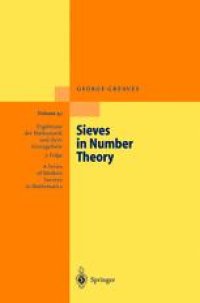
Ebook: Sieves in Number Theory
Author: George Greaves (auth.)
- Tags: Number Theory
- Series: Ergebnisse der Mathematik und ihrer Grenzgebiete 3. Folge A Series of Modern Surveys in Mathematics 43
- Year: 2001
- Publisher: Springer-Verlag Berlin Heidelberg
- Edition: 1
- Language: English
- pdf
Slightly more than 25 years ago, the first text devoted entirely to sieve meth ods made its appearance, rapidly to become a standard source and reference in the subject. The book of H. Halberstam and H.-E. Richert had actually been conceived in the mid-1960's. The initial stimulus had been provided by the paper of W. B. Jurkat and Richert, which determined the sifting limit for the linear sieve, using a combination of the ,A2 method of A. Selberg with combinatorial ideas which were in themselves of great importance and in terest. One of the declared objectives in writing their book was to place on record the sharpest form of what they called Selberg sieve theory available at the time. At the same time combinatorial methods were not neglected, and Halber stam and Richert included an account of the purely combinatorial method of Brun, which they believed to be worthy of further examination. Necessar ily they included only a briefer mention of the development of these ideas due (independently) to J. B. Rosser and H. Iwaniec that became generally available around 1971. These combinatorial notions have played a central part in subsequent developments, most notably in the papers of Iwaniec, and a further account may be thought to be timely. There have also been some developments in the theory of the so-called sieve with weights, and an account of these will also be included in this book.
This book surveys the current state of the "small" sieve methods developed by Brun, Selberg and later workers.. A self-contained treatment is given to topics that are of central importance in the subject. These include the upper bound method of Selberg, Brun's method, Rosser's sieve as developed by Iwaniec, with a bilinear form of the remainder term, the sieve with weights, and the use of Selberg's ideas in deriving lower-bound sieves. Further developments are introduced with the support of references t. The book is suitable for university graduates making their first acquaintance with the subject, leading them towards the frontiers of modern research and unsolved problems in the subject area.
This book surveys the current state of the "small" sieve methods developed by Brun, Selberg and later workers.. A self-contained treatment is given to topics that are of central importance in the subject. These include the upper bound method of Selberg, Brun's method, Rosser's sieve as developed by Iwaniec, with a bilinear form of the remainder term, the sieve with weights, and the use of Selberg's ideas in deriving lower-bound sieves. Further developments are introduced with the support of references t. The book is suitable for university graduates making their first acquaintance with the subject, leading them towards the frontiers of modern research and unsolved problems in the subject area.
Content:
Front Matter....Pages I-XII
Introduction....Pages 1-5
The Structure of Sifting Arguments....Pages 7-40
Selberg’s Upper Bound Method....Pages 41-70
Combinatorial Methods....Pages 71-101
Rosser’s Sieve....Pages 103-172
The Sieve with Weights....Pages 173-221
The Remainder Term in the Linear Sieve....Pages 223-258
Lower Bound Sieves when ? > 1....Pages 259-296
Back Matter....Pages 297-304
This book surveys the current state of the "small" sieve methods developed by Brun, Selberg and later workers.. A self-contained treatment is given to topics that are of central importance in the subject. These include the upper bound method of Selberg, Brun's method, Rosser's sieve as developed by Iwaniec, with a bilinear form of the remainder term, the sieve with weights, and the use of Selberg's ideas in deriving lower-bound sieves. Further developments are introduced with the support of references t. The book is suitable for university graduates making their first acquaintance with the subject, leading them towards the frontiers of modern research and unsolved problems in the subject area.
Content:
Front Matter....Pages I-XII
Introduction....Pages 1-5
The Structure of Sifting Arguments....Pages 7-40
Selberg’s Upper Bound Method....Pages 41-70
Combinatorial Methods....Pages 71-101
Rosser’s Sieve....Pages 103-172
The Sieve with Weights....Pages 173-221
The Remainder Term in the Linear Sieve....Pages 223-258
Lower Bound Sieves when ? > 1....Pages 259-296
Back Matter....Pages 297-304
....